Vol. 18 No. 11
December 1988/January 1989
|
Safety - Priority #1
|
Railway Sets Record for Moving Coal
By Jane Mudry
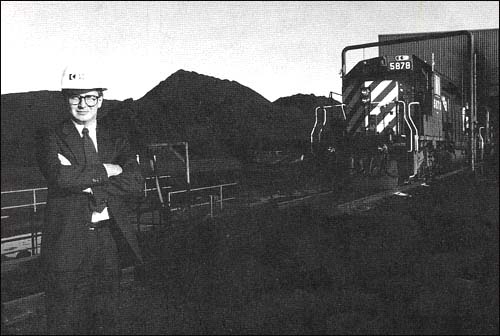
Doug Evanchuk, marketing representative coal, poses near the double dumper at Roberts Bank
where a unit train is about to begin unloading the latest shipment of coal from the mines in southeastern British Columbia. CP
Rail set an all-time record for moving coal in October, 1,920,935 tonnes.
|
Roberts Bank British Columbia - An impressive all-time record has been set with the
movement of 186 coal unit trains in October, easily surpassing the record set in September of 174.
Total shipments of coal for export and to eastern Canada were 1,920,935 tonnes in October and 1,834,589 tonnes in September.
A combination of three factors led to the achievement. Demand increased for coal destined for export markets as well as for Ontario
Hydro.
The second factor was a significant reduction in unit train cycle time between the southeast coal mines in B.C. and Roberts
Bank.
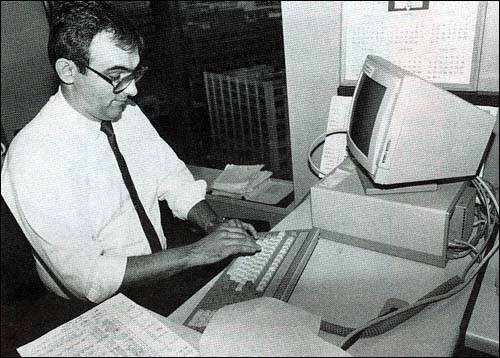
At his work station Gary Carefoot, coordinator of unit trains and bulk traffic, compiles the
information necessary to keep coal traffic moving efficiently.
|
ALL OUT EFFORT
And finally, the addition of an extra train set consisting largely of spare cars produced much needed additional short-term capacity.
"It is a situation in which everything counts. September's record of 174 trains topped the previous March, 1988, record of 173",
said Doug Evanchuk, marketing representative, coal.
"But everyone went all out to achieve the extraordinary record of 186 trains in October. Everyone put forward the extra effort
needed to get the job done."
Japan, Canada's largest coal customer, had consistent supply problems during the summer due to labor problems in Australia.
The southeast coal mines requested additional unit train service to meet the increased demand from their best customer.
"Canada has been able to enhance its worldwide reputation as a reliable supplier of coal," Mr. Evanchuk said. "As a
carrier, CP Rail reacted quickly on a short-term basis. It was a case of surge capacity meeting surge demand."
More than 75 percent of the coal was destined for overseas markets. Added to this westbound traffic are continuing shipments east to
markets in Ontario and the United States via Thunder Bay.
The breakdown for October was 151 trains to Roberts Bank and 35 east. Part of the eastbound traffic is lignite coal from Saskatchewan
destined for Ontario Hydro generating stations at Atikokan via Thunder Bay.
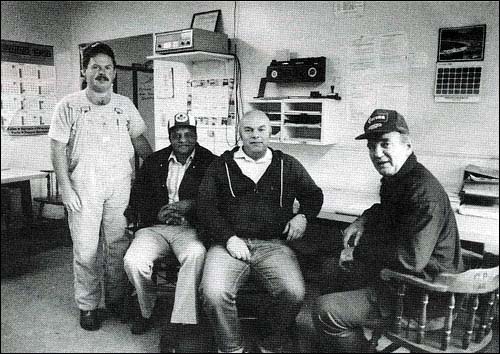
Waiting for their train at Roberts Bank are: (from left) Dave Gunderson trainman, Ken
Sekhon conductor, Jack Bleeker conductor, and Gerald Kendall locomotive engineer.
|
GOOD ATTITUDE
This has been a record year for moving this coal. The demand for lignite was driven up by both sustained low water levels at
hydro-electric generating stations in Ontario and by a strong economy.
The average cycle time between Roberts Bank and the southeast coal fields has been under 90 hours this year. This is considerably below
the 1984 average of 103.7 hours.
Each reduction of six hours in cycle time provides capacity equivalent to one additional train or about a million tonnes of coal a year.
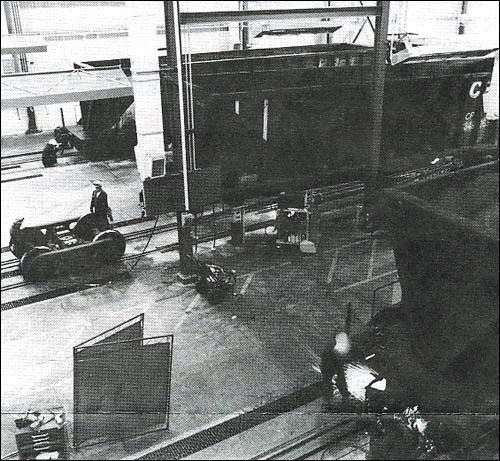
The carmen working at CP Rail's coal car repair shop in Golden, B.C., deserve a lot of credit
for the shop's performance. The shop has reduced the bad order ratio by 40 percent, improving the dependability of the railway
coal car fleet and enabling the addition of a 75-coal-car unit train to the system.
|
September's average cycle time was 87.9 hours, which was slightly more efficient than the year's
planned average. This was reduced to 85.6 hours in October. All components of the system, the mines, the railway, the port, operated at
peak efficiency.
"Just like you need oil to lubricate an engine, you need lubricant to make sure that trains run efficiently," said John Laing,
assistant superintendent. "The attitude of the running trades is the lubricant that moves the trains".
"A lot of terminals could not operate as efficiently as we do at Roberts Bank with 14 crews. The crews really do a good job keeping
the traffic going".
"Everyone working together is the key to getting the traffic to the terminal. A key is to avoid terminal detention time. It is
crucial to get the trains in, get them unloaded, and back to the coal fields quickly," Mr. Laing said.
Planning is crucial in keeping the train sets moving, according to Gary Carefoot, coordinator of unit trains and bulk traffic.
"We have to keep our customer satisfied," he said. "My job is not only to manage CP Rail's asset, coal unit trains, I also
work with our customers, and according to their requirements, help manage our customer's product, coal.
"The efficient allocation of train sets minimizes delays in the cycle. The record movement has been achieved partly because of the
most effective use of train sets we've ever had. Not only are we having an excellent turnaround time with Roberts Bank coal but the
Thunder Bay cycle time is the best it's ever been," he said.
The return cycle between Thunder Bay and the southeast coal fields over the 2,240-kilometre round trip is about 132 hours.
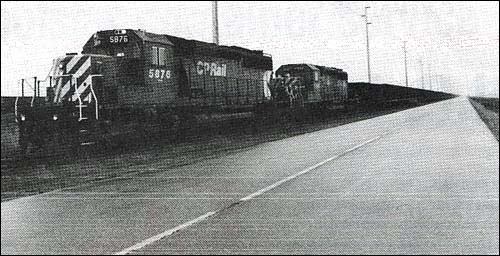
Train No. 5876 arrives on the causeway leading to Roberts Bank with a 111 carloads of coal. The
coal port here has two rotary dumpers, and a single dumper, which can unload a unit train in five hours. In the background is an
empty train heading back to the coal mines of southeastern British Columbia.
|
The third contributing factor to the record train movements was the addition of an extra train
set to the fleet on 19 Sep 1988 bringing the number to 22.
This train set was made up of 75 spare coal cars that were on hand at the Golden coal car repair shop. It was brought up to a full
complement of 111 cars through the addition of cars from sulphur service.
Bill Plohman, assistant chief of unit mechanical, car maintenance, explained that car reliability aided in ensuring enough equipment was
available.
"The coal car repair shop is performing as planned, reducing the bad order ratio by 40 percent, so we were able to supply the 75
cars. These cars had been stationed at Golden to replace bad orders. We were able to free them for revenue service because of the overall
dependability of the fleet," he said.
This CP Rail News article is copyright 1989 by the
Canadian Pacific Railway and is reprinted here with their permission. All
photographs, logos, and trademarks are the property of the Canadian Pacific Railway Company.
 
|